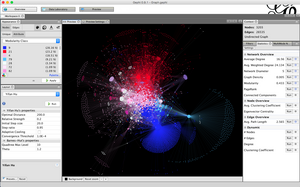Gephi
| Gephi
|
|
|---|---|

|
|
 Screenshot from Gephi 0.9.1 |
|
| Basic data
|
|
| Maintainer | Mathieu Bastian, Eduardo Ramos Ibañez, Mathieu Jacomy, Cezary Bartosiak, Sébastien Heymann, Julian Bilcke, Patrick McSweeney, André Panisson, Jérémy Subtil, Helder Suzuki, Martin Skurla, Antonio Patriarca |
| Publishing year | 2008 |
| Current version |
0.9.2 ( September 24, 2017 ) |
| operating system | Linux , Windows , macOS |
| programming language | Java , OpenGL |
| category | Visualization |
| License | GNU General Public License , Common Development and Distribution License |
| German speaking | Yes |
| https://gephi.org/ | |
Gephi is an open source software package for network analysis and visualization that was written in the Java programming language . It uses the NetBeans platform .
history
Initially, Gephi was developed by students at the University of Technology of Compiègne (UTC) in France. Gephi participated in the Google Summer of Code in 2009, 2010, 2011, 2012, and 2013.
The latest version, 0.9.0, was released in December 2015. Updates appeared in February 2016 (0.9.1) and September 2017 (0.9.2). Previous versions are 0.6.0 (2008), 0.7.0 (2010), 0.8.0 (2011), 0.8.1 (2012) and 0.8.2 (2013).
The Gephi Consortium, founded in 2010, is a not-for-profit organization under French law that supports the further development of the software. Her members include SciencesPo , Linkfluence , WebAtlas and Quid. Gephi is supported by a large community of users. There is a Facebook group, a forum and numerous guides on websites and blogs.
Features and special features
Gephi uses OpenGL for visualization and thus the graphics card for graphic display. This allows Gephi networks with over 20,000 nodes to process without using the main processor .
Implemented layout algorithms
Gephi provides various algorithms to arrange the nodes of a network.
- Fruchterman Reingold
- Force Atlas2
- Yifan Hu algorithms
Supported file formats
Applications
Gephi is used in science and journalism to visualize network data.
For example, social unrest was traced on Twitter. Renowned newspapers such as the New York Times use Gephi to prepare data and to do everything to do with network analysis. Gephi is widespread in the science of the digital humanities , to which many of the software developers themselves belong.
See also
Web links
Individual evidence
- ↑ launchpad.net .
- ↑ Release 0.9.2 . September 24, 2017 (accessed March 13, 2018).
- ^ Martin Grandjean: La connaissance est un réseau . In: Les Cahiers du Numérique . 10, No. 3, 2014, pp. 37-54. doi : 10.3166 / lcn.10.3.37-54 . Retrieved October 15, 2014.
- ^ A b Mathieu Bastian, Sebastien Heymann, Mathieu Jacomy: Gephi. An Open Source Software for Exploring and Manipulating Networks . In: AAAI Publications, Third International AAAI Conference on Weblogs and Social Media . 2009. Retrieved November 22, 2011.
- ↑ Patrice Desmedt: Sébastien Heymann - Le cartographe des données . In: L'Usine Nouvelle . 2011. Retrieved December 14, 2011.
- ↑ Gephi 0.9 released
- ↑ Gephi updates with 0.9.1 version
- ↑ Gephi 0.9.2: a new CSV importer
- ↑ List of versions, on GitHub
- ^ The Gephi Consortium - Members . The Gephi Consortium. Archived from the original on November 7, 2011. Info: The archive link was automatically inserted and not yet checked. Please check the original and archive link according to the instructions and then remove this notice. Retrieved November 23, 2011.
- ↑ Gephi Facebook group
- ↑ Gephi forum
- ↑ Martin Grandjean: Gephi - Introduction to Network Analysis and Visualization . 2015. Retrieved August 15, 2016.
- ↑ Devangana Khokhar: Gephi cookbook: over 90 hands-on recipes to master the art of network analysis and visualization with Gephi . Birmingham, UK 2015, ISBN 978-1-78398-741-2 , Chapter 3. Using Graph Layout Algorithms (English, proquest.safaribooksonline.com ).
- ^ Thomas MJ Fruchterman, Edward M. Reingold: Graph drawing by force-directed placement . In: Software: Practice and Experience . tape 21 , no. 11 , November 1, 1991, ISSN 1097-024X , pp. 1129–1164 , doi : 10.1002 / spe . 4380211102 .
- ↑ Mathieu Jacomy, Tommaso Venturini, Sebastien Heymann, Mathieu Bastian: ForceAtlas2, a Continuous Graph Layout Algorithm for Handy Network Visualization Designed for the Gephi Software . In: PLOS ONE . tape 9 , no. 6 , June 10, 2014, p. e98679 , doi : 10.1371 / journal.pone.0098679 .
- ^ Yifan Hu: Efficient and high quality force-directed graph drawing . In: Mathematica Journal . tape 10 , no. 1 , 2005 ( mathematica-journal.com ).
- ↑ Jadaliyya - جدلية: Collateral Damage: #Oslo Attacks and Proliferating Islamophobia. Retrieved January 25, 2018 .
- ↑ Kalev Leetaru: Culturomics 2.0: Forecasting large-scale human behavior using global news media tone in time and space . In: First Monday . tape 16 , no. August 9 , 17, 2011 ( journals.uic.edu [accessed January 25, 2018]).
- ^ Debora C. Correa, Luciano da Fontoura Costa, Jose H. Saito: Using Digraphs and a Second-Order Markovian Model for Rhythm Classification . In: Complex Networks (= Communications in Computer and Information Science ). Springer, Berlin / Heidelberg 2011, ISBN 978-3-642-25500-7 , pp. 85-95 ( link.springer.com [accessed January 25, 2018]).
- ↑ Martin Grandjean: Analisi e visualizzazioni delle reti in storia. L'esempio della cooperazione intellettuale della Società delle Nazioni . In: Memoria e Ricerca . No. 2, 2017, pp. 371–393. doi : 10.14647 / 87204 .
